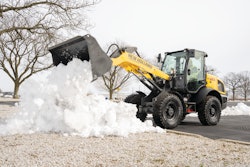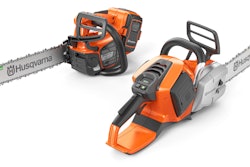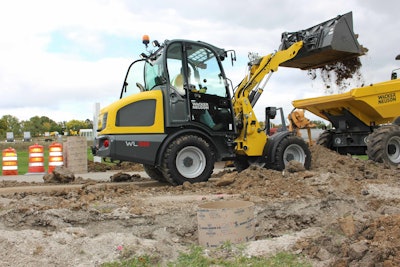
First it was skid steers, then compact track loaders. Now there’s a new player gaining market share.
The spotlight is shifting to small articulated loaders.
They may well be the most versatile, useful type of compact equipment, filling a void created as skid steers and CTLs keep getting bigger.
Small articulated loaders are defined as having up to 75 horsepower and a rated operating capacity of up to 3,500 kilograms, or 7,716 pounds.
As manufacturers of skid steers and compact track loaders have focused on the upper end of their product lines, some customers feel the smaller machines have been neglected.
Legacy brands have been building small articulated loaders for years, but as the popularity soars, more players are entering the market.
And why the soaring popularity?
Because of their geometry, SALs have high lift capacity as a percentage of operating weight. That provides great performance from a machine that’s easily transportable. They are available in multiple configurations, including diesel and battery electric, fixed or telescopic boom, and with couplers that include CII (common industry interface), skid steer and mini-skid steer. And, of course, their articulation joint means increased maneuverability.
SALs cause much less surface disruption than heavier machines that rely on counter-rotation for turning, such as skid-steer and compact track loaders. They are therefore better suited to finished surfaces and rarely require guarding over curbs and other ground features.
Small articulated loaders can have high-flow hydraulic performance, making them suitable for a wide range of attachments. And they have a narrow width for use on sidewalks, trails and similar spaces.
Small articulated loaders are relatively low-cost machines. Operation is not intimidating for less-experienced operators. They’re easy to store in a garage, and many can be trailered with a half-ton pickup truck.
These features and more make them popular with a wide range of customers, from construction and landscaping to forestry and rural lifestyle.
As to limitations, there is only one that stands out.
SALs have a wider turning radius than skid steers and CTLs because those two have counter-rotation and can turn in their own length. On really tight jobsites, a small skid steer or CTL is the better choice. And in ground-engaging tasks, CTLs are better because of their higher tractive effort.
How to Choose the Right SAL
As a category, small articulated loaders are diverse and versatile. But individual models are not.
Perhaps more than with other categories of equipment, SALs require customers to have a thorough understanding of their intended applications when choosing a model. There are three main areas to consider:
- Boom configuration. Small articulated loaders are, by definition, small. If your applications include loading over the sides of trucks or retaining walls or into hoppers, a model's hinge pin height may not be sufficient. Telescopic booms are available but may sacrifice breakout and bucket force for height. At least two manufacturers, Giant with their “X-Tra” models and Mecalac with their “+” models, offer shorter lift arms for greater digging forces.
- Operator station. Choices include open ROPS, both fixed and foldable, and cabs, but the placement of the operator station varies much more than with other types of equipment. Placement affects comfort and visibility, including sight to the attachment.
- Attachment support. Dan Kakareka, product manager, New Holland Construction, says SALs are commonly bundled with three or four attachments at the time of purchase. Investigate the huge range of attachments available for SALs before spec’ing your machine. You may well find attachments to bring greater utilization, and therefore greater revenue, with your new loader – if it’s spec’ed properly. Ask yourself: How much hydraulic performance will you need? What coupler is required? Will you need a 14-pin connector? What about creep mode? How about turf tires for minimal surface disruption or skid steer tires to better withstand cuts and punctures?
Here are some samples of SALs on the market:
Bobcat
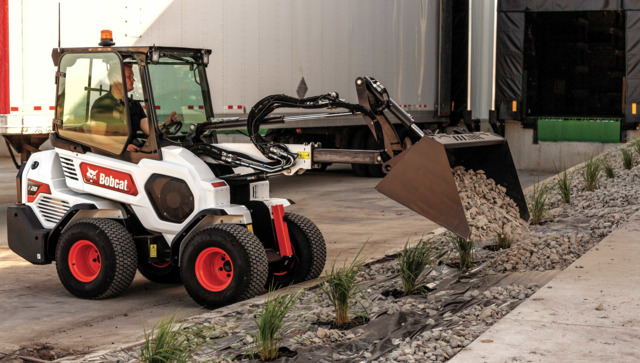 The 24.8-horsepower Bobcat L28 has an operating weight of 4,195 pounds and ROC of 1,534 pounds straight and 1,222 pounds articulated; those values go to 1,952 pounds and 1,475 pounds with the optional counterweight. Outside turning radius is 100.9 inches; hinge pin height is 85.4 inches or 104.3 inches with the boom extended.BobcatBobcat’s L23 and L28 come equipped with steering wheels and foot pedals, making them easier for new operators to run.
The 24.8-horsepower Bobcat L28 has an operating weight of 4,195 pounds and ROC of 1,534 pounds straight and 1,222 pounds articulated; those values go to 1,952 pounds and 1,475 pounds with the optional counterweight. Outside turning radius is 100.9 inches; hinge pin height is 85.4 inches or 104.3 inches with the boom extended.BobcatBobcat’s L23 and L28 come equipped with steering wheels and foot pedals, making them easier for new operators to run.
They’re just under 6.5 feet long and can easily be stored in a standard garage. To optimize performance in a range of underfoot conditions, Bobcat SALs have two automatic traction modes: High-Traction for rough and slippery conditions and Turf-Safe for improved surfaces. An optional traction-assist switch allows the operator to manually override the automatic setting momentarily.
The optional hydraulic Bob-Tach system allows operators to swap non-hydraulic attachments without leaving the cab.
“Overall, small articulated loaders are a very friendly entry point for customers new to compact equipment,” says Mike Fitzgerald, marketing manager, Bobcat Company, “and Bobcat’s range of standard and optional equipment makes these machines even more approachable.”
Case
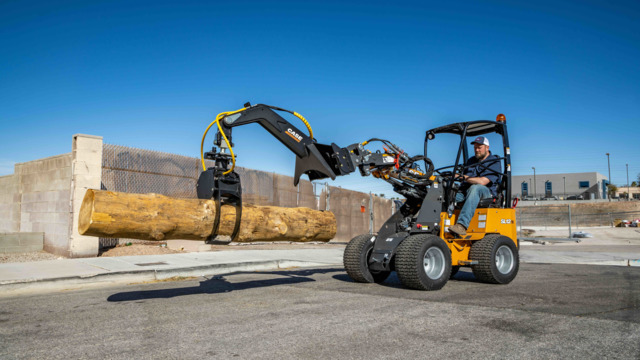 The 25-horsepower Case SL12 TR is just 36 inches wide, has an outer turning radius of 77.4 inches and maximum dump height of 81.1 inches. Standard features include a ROPS/FOPS roof, hydrostatic 4WD, three-spool main control valve and hydraulic boom suspension (ride control). Options include a hand throttle and hand control for inching.Case CECase launched its line of six small articulated loaders at the Equip Exposition in 2023 with the telescopic-boom SL12 TR.
The 25-horsepower Case SL12 TR is just 36 inches wide, has an outer turning radius of 77.4 inches and maximum dump height of 81.1 inches. Standard features include a ROPS/FOPS roof, hydrostatic 4WD, three-spool main control valve and hydraulic boom suspension (ride control). Options include a hand throttle and hand control for inching.Case CECase launched its line of six small articulated loaders at the Equip Exposition in 2023 with the telescopic-boom SL12 TR.
The rollout will continue into 2024. Models will range from 24 to 74 horsepower, 1,500 to more than 3,000 pounds operating capacity, telescopic and Z-bar lift and compatibility with more than 110 attachments.
“When it comes to attachments on our small articulated loaders, we’re giving contractors a whole arsenal of tools to handle almost any task,” says Ryan Anderson, product manager, MTL/SAL, Case Construction Equipment. “But the versatility doesn’t stop there. We designed these machines with common industry couplers so contractors can also leverage a wide range of Case and non-Case attachments.”
Electric models will join diesel machines in the lineup. The SL22EV matches its diesel counterparts for power and can be fully charged in just one hour, Case says.
Giant
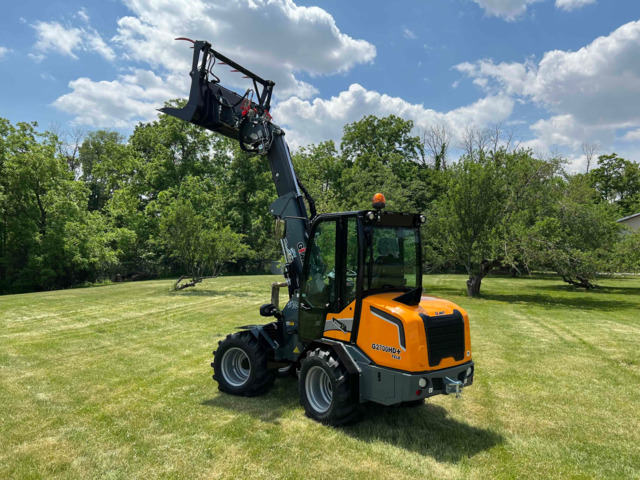 The Giant G2700 HD+ is one of four iterations with a 50-horsepower Kubota engine; there is also a 2700E electric model. The diesel models have 13.5 gpm with an 18.5 gpm high-flow option. The HD+ and X-Tra HD+ have operating weights of 5,733 pounds. Tire options include tread patterns, rim offsets, as well as diameter and width.Tobroco-GiantFounded in 1996, Tobroco-Giant is a legacy manufacturer of small articulated loaders and has developed a diverse line over the decades.
The Giant G2700 HD+ is one of four iterations with a 50-horsepower Kubota engine; there is also a 2700E electric model. The diesel models have 13.5 gpm with an 18.5 gpm high-flow option. The HD+ and X-Tra HD+ have operating weights of 5,733 pounds. Tire options include tread patterns, rim offsets, as well as diameter and width.Tobroco-GiantFounded in 1996, Tobroco-Giant is a legacy manufacturer of small articulated loaders and has developed a diverse line over the decades.
It offers fully mechanical models up to 25 horsepower for a simple, lower-cost selection for customers needing that option. Other models range up to 74 horsepower.
All engines are Kubota except for the G5000, which has either Kubota or Deutz power available. The G2200E and G2700E are plug-in, battery electric machines.
Hydraulic flows vary from 7.4 to 35.7 gallons per minute, and travel speeds reach 21.6 mph. Four models have telescopic booms.
Depending on the size of the machine, Giant configures models with either CII or skid-steer plate connectors. Arm options include standard, X-tra and telescopic for optimal balance of reach, lift and bucket and boom forces.
Rudolf de Jong, president of Giant Loaders, says that in a category where variety is common, “Giant stands out for the diversity of small articulated loaders we offer.”
Intrepid
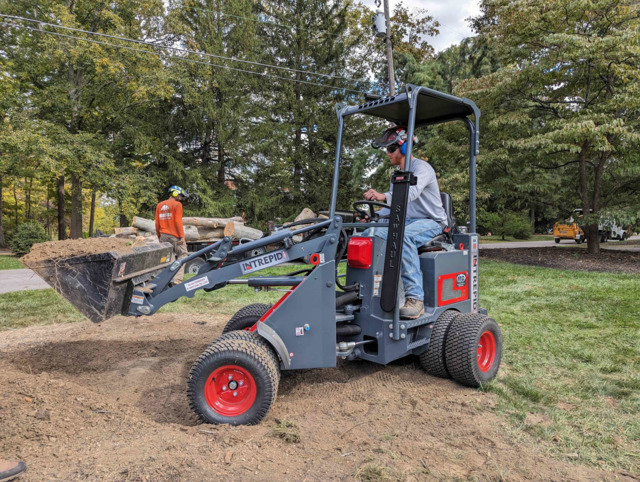 The Intrepid KM85 is powered by a D902 Kubota engine rated at 23 horsepower. Operating weight is 1,970 pounds, and ROC is 1,540 pounds. Hydraulic numbers are 7.4 gpm at 2,600 psi. Travel speed is up to 8 mph. Standard and optional equipment include a mini-skid-steer attachment plate, LED work lights, ROPS/FOPS roof, engine and hydraulic tank pre-heater, and counterweights.KnikmopsIn 1997, Belgian company Knikmops manufactured its first small articulated loader. Its current Intrepid KM100 is based on that machine.
The Intrepid KM85 is powered by a D902 Kubota engine rated at 23 horsepower. Operating weight is 1,970 pounds, and ROC is 1,540 pounds. Hydraulic numbers are 7.4 gpm at 2,600 psi. Travel speed is up to 8 mph. Standard and optional equipment include a mini-skid-steer attachment plate, LED work lights, ROPS/FOPS roof, engine and hydraulic tank pre-heater, and counterweights.KnikmopsIn 1997, Belgian company Knikmops manufactured its first small articulated loader. Its current Intrepid KM100 is based on that machine.
It is a telescopic model and is joined the telescopic KM130 and the non-tele KM85 to round out Intrepid’s three-model lineup.
All three have Kubota engines. The KM85 is rated at 23 horsepower, and the two telescopic models are 25 horsepower.
The KM85 comes standard with dual wheels in all four positions; the KM100 and KM130 have dual-wheel options. The dual-wheel design gives customers the opportunity to prioritize flotation or width.
Chris Sleurink of Intrepid says the KM85 was added to the line to offer a step up for customers who had outgrown compact utility loaders.
The KM85 and KM100 Tele are ROPS/FOPS canopy only. The KM130 Tele is canopy or cab. Optional counterweights increase operating weight and lift capacity.
Mecalac
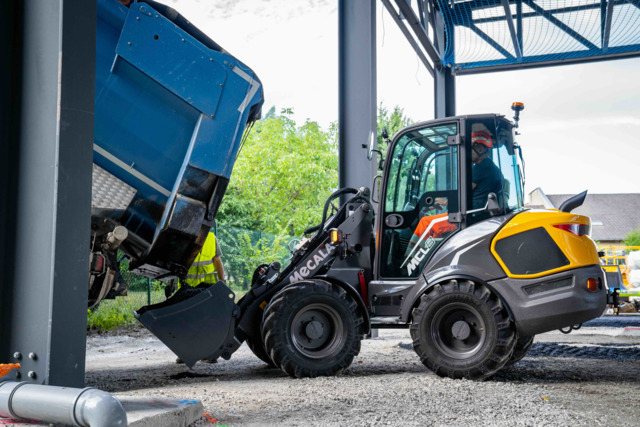 The biggest of the six Mecalac models, the 49-horsepower MCL8 has an operating weight of 6,283 pounds. Hydraulic performance is 13.2 gpm at 3,000 psi. Two-speed drive is standard and provides a maximum travel speed of 12 mph, with a high-speed option providing up to 19 mph. The standard configuration is a canopy; cabs with heating or with heating and air conditioning are optional.MecalacMecalac has six models of small articulated loaders, from the 3,836-pound, 25-horsepower MCL2 to the 6,283-pound, 49-horsepower MCL8.
The biggest of the six Mecalac models, the 49-horsepower MCL8 has an operating weight of 6,283 pounds. Hydraulic performance is 13.2 gpm at 3,000 psi. Two-speed drive is standard and provides a maximum travel speed of 12 mph, with a high-speed option providing up to 19 mph. The standard configuration is a canopy; cabs with heating or with heating and air conditioning are optional.MecalacMecalac has six models of small articulated loaders, from the 3,836-pound, 25-horsepower MCL2 to the 6,283-pound, 49-horsepower MCL8.
Each is available with ROPS canopy or cab; cabs with HVAC are available only on the 25-horsepower MCL6 and MCL8 as they have sufficient horsepower to run A/C without significantly detracting from loader performance.
Heated, pneumatic seating is available in all models. Hydraulic and electrical connectors are available for the rear of the machine; one application would be snow removal at the front of the machine with a salt spreader at the back.
Regional sales representative Ryan Carter points out that boom and bucket float and ride control are available options on all models. Creep mode is standard on the MCL6 and MCL8 and optional on all others.
Peter Bigwood, general manager, Mecalac North America, says the same construction standards and technology found in Mecalac’s larger loaders are present in these MCL models. “Because small articulated loaders are popular with casual users, such as rural lifestyle dwellers, some OEMs build to a lesser standard in order to hit a price point. Mecalac has chosen to build the MCL line as bona fide commercial machines.”
The risk, says Bigwood, is sticker shock, but that is allayed when customers understand the additional value of Mecalac’s tough design and materials.
New Holland
 The New Holland ML12T (shown) is a telescopic-reach model; the ML12 is the non-telescoping version. Both have Kubota D902 engines rated at 25 gross horsepower. The “T” version has an operating weight of 2,646 pounds with the ROPS/FOPS canopy; no cab is offered. Auxiliary hydraulics provide 7.4 gpm at 2,200 psi; a second auxiliary circuit with the same specs is an available option.New HollandAmong the several New Holland models are the ML12 and ML12T with telescoping boom.
The New Holland ML12T (shown) is a telescopic-reach model; the ML12 is the non-telescoping version. Both have Kubota D902 engines rated at 25 gross horsepower. The “T” version has an operating weight of 2,646 pounds with the ROPS/FOPS canopy; no cab is offered. Auxiliary hydraulics provide 7.4 gpm at 2,200 psi; a second auxiliary circuit with the same specs is an available option.New HollandAmong the several New Holland models are the ML12 and ML12T with telescoping boom.
The ML35T and ML50T are telescoping only.
A fully electric model, the ML22X, should be available by the third quarter of 2024.
Kakareka says the New Holland design, including the placement of the operator station and the articulation joint, yields several benefits. One is high lift capacities.
While lift capacity varies with load placement and machine configuration, maximum lift for the ML12 is equivalent to the machine’s operating weight – both are 2,425 pounds.
The rear segments do not swing out in turns, so operators can work closer to walls and other obstacles. Control is via single mechanical joystick. Options include creep speed and ride control for the loader arms.
“There will be a learning curve with a small articulated loader,” says Kakareka, “but overall they are easy to operate and easy to service.”
Wacker Neuson
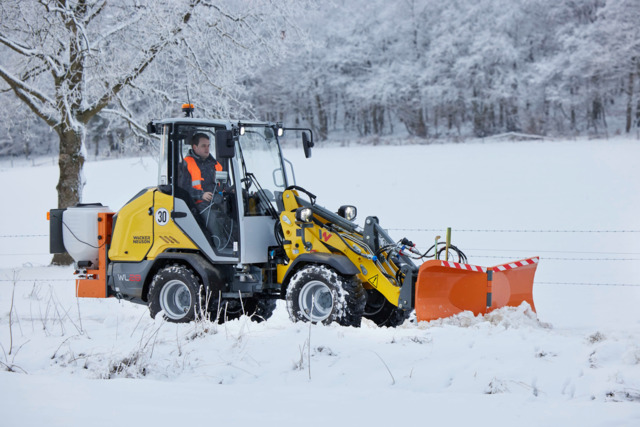 The WL28 is the newest model in Wacker Neuson’s lineup of small articulated loaders. Auxiliary hydraulic numbers are 9.5 gpm at 3,045 psi. Operating weight is 6,040 pounds. Travel speed is 12.4 mph, or 18.6 mph with optional high-speed. The drive system is electronically regulated with up to four drive modes. The comfort cab is suitable for tall operators and features a panoramic rear window for all-around visibility.Wacker NeusonWacker Neuson offers four models of small articulated loader under 75 horsepower: the WL28, WL34, WL38 and WL52, with operating weights from 6,040 to 11,243 pounds.
The WL28 is the newest model in Wacker Neuson’s lineup of small articulated loaders. Auxiliary hydraulic numbers are 9.5 gpm at 3,045 psi. Operating weight is 6,040 pounds. Travel speed is 12.4 mph, or 18.6 mph with optional high-speed. The drive system is electronically regulated with up to four drive modes. The comfort cab is suitable for tall operators and features a panoramic rear window for all-around visibility.Wacker NeusonWacker Neuson offers four models of small articulated loader under 75 horsepower: the WL28, WL34, WL38 and WL52, with operating weights from 6,040 to 11,243 pounds.
Wacker Neuson has focused special attention on operator comfort. “It is the foundation of the wheel loaders’ design,” says Jay Quatro, commercial product manager, Wacker Neuson. “In the long run, comfort improves both safety and productivity.”
The WL28 is the newest model and exemplifies the company’s focus on comfort with a spacious cab, excellent visibility, intuitive controls, air conditioning, and LED driving and work lights. Options include 45- or 54-horsepower Yanmar engines.
Auto and eco modes are standard, while an optional attachment mode prioritizes power to the front auxiliary attachment for consistent flow and power to the work tool. The electronically regulated drive system provides improved pushing power and travel speeds up to 18.6 mph with the high-speed option.


